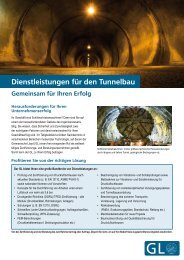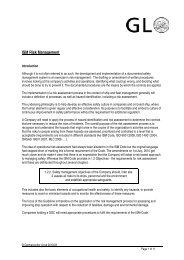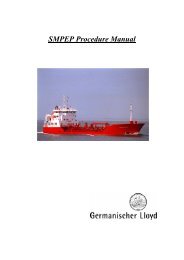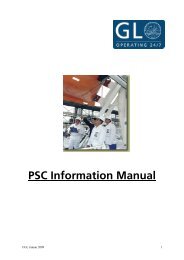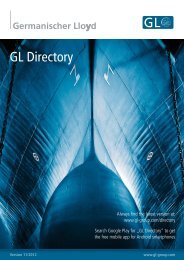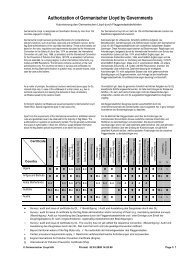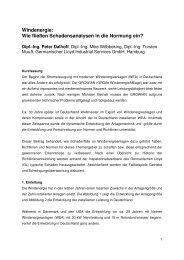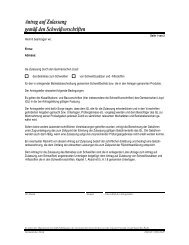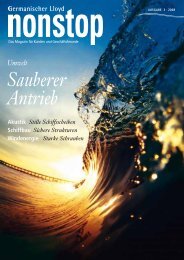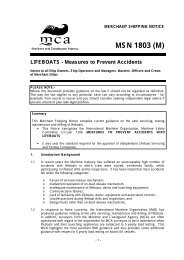Yards Moving Forward - GL Group
Yards Moving Forward - GL Group
Yards Moving Forward - GL Group
You also want an ePaper? Increase the reach of your titles
YUMPU automatically turns print PDFs into web optimized ePapers that Google loves.
MODERN DAMAGE ANALYSIS<br />
To Be or not to Be<br />
“In cases like these, we always begin by checking the<br />
material properties,” is how Manfred Feyer describes the<br />
usual procedure. “After all, a mistake in material selection or<br />
application cannot be ruled out until the opposite has been<br />
proven. First of all, we have to answer what is perhaps the<br />
most trivial question of all: is the material in question really<br />
what it claims to be, i.e. according to specifications?”<br />
To determine this, the component fragment must be subjected<br />
to a certain amount of violence. It is pulled, bent and<br />
etched literally beyond the limits of endurance. The first<br />
ordeal is called the test of tensile strength. Here the laboratory<br />
technicians extract a tensile sample from the shaft of the bolt<br />
and apply a precisely defined tensile test to ascertain the<br />
strength of the material. This value is then compared with the<br />
requirements set by the corresponding standard of the supposed<br />
material. Then the so-called “notched bar impact test”,<br />
which measures the tenacity of the material, is performed. For<br />
this, a specimen is notched on one side and attacked with a<br />
pendulum hammer. Depending on how much energy the<br />
sample absorbs – how tough it is – the pendulum hammer<br />
swings back up to a varying degree. However, the tenacity is<br />
not only a function of the material, but also depends on the<br />
environmental conditions, particularly the temperature. The<br />
environmental parameters must therefore be monitored<br />
closely to obtain reliable data.<br />
If the values determined in the tests correspond to the<br />
standard values for the material, then it is most probable that<br />
the correct material has indeed been used. Final certainty is<br />
offered by the chemical analysis. With the aid of a spectrometer,<br />
the technicians draw an electric arc – like that used in<br />
welding – from the material sample. The spectrometer analyses<br />
the spectrum of the electric arc, which is characteristic for<br />
a certain material composition. This method, which can be<br />
used for all metallic materials, e.g. those with an iron, nickel,<br />
aluminium and copper basis, now provided an exact analysis<br />
of the alloying constituents used in our mystery material.<br />
High-resolution Analysis<br />
In the case of the cylinder-head bolt, the conclusion was<br />
crystal-clear: it had indeed been made of the specified<br />
chrome-molybdenum steel – there had been no error in the<br />
choice of material. The actual reasons for failure were still<br />
unknown, but Feyer was now able to rule out a number of<br />
likely causes. The breakthrough then came with the microscopic<br />
examination. In addition to the light-microscopy with<br />
a magnification of some 1000 times, the test technicians at<br />
<strong>GL</strong>P also use the 20,000-fold magnification of a scanning electron<br />
microscope. The sharp vision of this high-resolution<br />
analysis device proved to be irresistible: In the thread root –<br />
the starting point for crack formation – minute traces of corrosion<br />
could be seen. “The question as to why the crack had<br />
started in the first place could therefore be answered conclusively,”<br />
Feyer was pleased to report. The corrosion disturbed<br />
the overall balance of admissible stresses in the bolt, resulting<br />
in a micro-crack, which then grew to a size that compromised<br />
the integrity of the component. The rest of the investigation<br />
was routine: “In the servicing instructions for the engine, we<br />
found a clear description of how the cylinder-head bolts had<br />
to be mounted,” explained Feyer, “namely with the use of a<br />
sealant to keep moisture out of the thread. This had evidently<br />
62 nonstop 3/2006<br />
Ruptured surface with the lines of rest that are typical of fatigue fractures<br />
been neglected during the last maintenance.” The servicing<br />
error was thus proven beyond doubt. A silver lining in the<br />
cloud for the shipowner, but bad luck for the servicing company<br />
which had been entrusted with the maintenance. “Once<br />
this test report was received, they had to call up their insurance<br />
company right away.”<br />
Look before You Leap<br />
The financial benefit which the customer can obtain from<br />
the advanced apparatus and high-level expertise of <strong>GL</strong>P is not<br />
always as clearly visible and rapidly applied as in this example.<br />
In particular, failure prevention calls for a long-term perspective.<br />
“The significance of consultative material examination<br />
– another source of business for us – is increasing steadily,”<br />
Feyer explains. The realization is growing that not all<br />
structural design features can be optimized by computer –<br />
residual uncertainties will always remain. Sometimes, it is<br />
merely that the operating data with which a process or component<br />
could be optimized is missing. Take spot-welding in<br />
the processing of sheet metal, for instance: to be able to meet<br />
the quality objectives it has set itself, a certain company is<br />
having the preproduction series of a safety-relevant tank<br />
examined by <strong>GL</strong>P. With success, as Manfred Feyer emphasizes:<br />
“We were able to give specific advice on optimizing the<br />
methods being applied.”<br />
A valuable contribution towards preventing damage is<br />
undoubtedly the close cooperation of <strong>GL</strong>P with the central<br />
damage management of <strong>GL</strong>. The constant feedback of information<br />
helps to detect and avert unfavourable developments<br />
at an early stage. In this regard, the broad line-up of the <strong>GL</strong><br />
<strong>Group</strong> is proving its worth, as it not only certifies but also tests<br />
and monitors the application of technology. “Whenever we<br />
identify a pattern in cases of damage, this is incorporated into<br />
our rules and guidelines,” Feyer notes.<br />
Not all of the assignments that land on Feyer’s desk, or on<br />
those of his colleagues in Mülheim, Herne and Stuttgart,<br />
demand such a “good nose”, as in the case of the corroded<br />
cylinder-head bolt. There are also the many everyday jobs –<br />
routine examinations that are performed within the scope of<br />
material certifications, product modifications, or changes of<br />
vendor or materials. But they too can save the customer a lot<br />
of money – when a company switches its supplier of cast parts,<br />
for example. The dimensional accuracy of the components<br />
can be checked by any suitably equipped incoming inspection<br />
department, but the material properties are a matter for a fullblown<br />
laboratory. Manfred Feyer is convinced: “Calling in <strong>GL</strong>P<br />
could help prevent quite a few product recalls!” ■ JI<br />
For further information: Dr. Manfred Feyer, Managing Director of Germanischer Lloyd<br />
Prüflabor, Phone: +49 40 20003-970, manfred.feyer@gl-group.com





